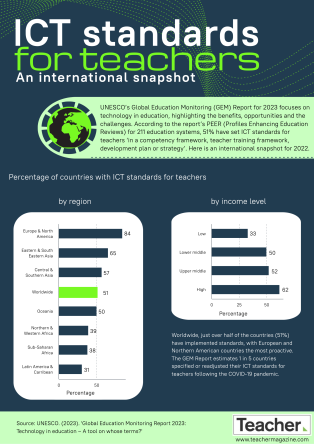The National Assessment Program (NAP) – Information and Communication Technology (ICT) Literacy, or NAP-ICT Literacy, has measured the skills of Australian students in year 6 and 10 every 3 years since 2005. The most recent assessment was delayed 2 years due to COVID-19, with the national report on the 2022 assessment published in late 2023. In 2020, revisions to the NAP-ICT Literacy Assessment Framework were made to more clearly align it with the Australian Curriculum: ICT Capability and the Australian Curriculum: Digital Technologies.
In our latest expert Q&A we catch up with Dr Tim Friedman and Dr Kristy Osborne from the Australian Council for Educational Research to find out more about the changes to NAP-ICT Literacy, what teachers can learn from the latest round of student achievement data, and classroom activities to support student learning.
The definition of ICT Literacy has been expanded to include both ‘computational, design and systems thinking to create solutions’ and engaging ‘productively with emerging and future technologies’. What implications would that have to the teaching of ICT?
The main purpose of ICT education is to ensure our next generation is equipped with the skills and foundational knowledge to engage with, and develop, new technologies. As technology evolves, so too must the teaching of ICT literacy. Studies like the International Computer and Information Literacy Study (ICILS) show that young people do not develop sophisticated digital skills just by growing up using digital devices – adults need to foster this learning at home and in school. That’s why the teaching of ICT now includes concepts like privacy and online security.
Computational thinking – organising information, findings patterns and creating routines or algorithms – is an integral part of ICT Literacy that enables young people to create digital solutions to problems. That’s becoming increasingly important in work and everyday life. And there is now an explicit focus in ICT education on engaging students with real-world problems that interest them. It’s been shown that engaging students with real-world problems has the potential to increase their engagement, as well as encourage more female participation in ICT-related professions and tertiary study. Teachers can do this by asking students to choose their own problems to solve, then working with them to co-develop the design criteria for their chosen problem.
The most recent NAP-ICT Literacy was delayed 2 years due to COVID-19, with the national report on the 2022 assessment published in late 2023. What does it tell us about the skills of year 6 students?
At the national level in 2022, 55% of year 6 students reached the proficient standard, which is similar to 2017 when 53% achieved the standard. Students who achieve the standard can create basic search queries, choose appropriate information sources, and interpret data from digital sources to answer specific questions. They can identify errors in simple digital forms, organise information logically, edit and format using standard software commands, and understand basic digital technology concepts. They also can connect components of a simple digital system. So, we know that just under half of students in year 6 cannot perform many of these basic skills.
Where should teachers focus ICT learning for this age group?
Students in this age group would benefit from collaborative opportunities to develop solutions to a problem, such as developing user interfaces (on paper or digitally) for an app. A great example is an app that enables students to vote for a fundraising activity, a new team mascot or colour for their school sports team, or types of pizza for an end of year function. Whatever it is, though, the app should relate to the real world and ideally be something the group decides on together. That addresses that idea of helping students to see the real-world relevance of ICT and allowing them to choose an activity they are personally interested in.
The NAP-ICT Literacy survey also showed us that 83% of Australian year 6 students learn about how to protect their personal safety when communicating with strangers online but around one-third aren’t learning about interacting with emails safely. Instruction and examples that demonstrate the importance of checking where a message is from before clicking on links, or how to discern the safety of a source before opening an attachment, could introduce these basic skills.
Only 46% of year 10 students who took part in the assessment reached the proficient standard in their use of ICT. What were the gaps in their knowledge, skills and understanding, and what can teachers do to address this?
The data from the NAP-ICT Literacy survey suggests that more than half of year 10 students don’t have the skills and knowledge that we would hope they would have as they enter the last years of secondary school in preparation for further study or employment. In fact, the percentage of Year 10 students reaching the proficient standard (46%) was down by 8 percentage points compared to the 2017 results.
The gaps indicate that year 10 students need more support in learning skills to create basic search queries or select the best sources for specific goals. They also need more support in interpreting data from digital sources to answer precise questions, implementing solutions to gather user information, organising information logically to create products, editing and formatting using standard software commands, and exploring digital technology concepts. Other knowledge gaps identified included the important skills of being able to identify common instances of ICT misuse, such as plagiarism, computer viruses and deliberate identity concealment, and being able to suggest prevention strategies.
What kind of classroom activities could teachers introduce to support students in developing ICT skills?
Analysing and visualising data in spreadsheets and databases has become an explicit focus of the v9.0 Digital Technologies curriculum. The 2022 cycle of NAP-ICT Literacy introduced a new question asking students about their participation in activities related to Digital Technologies during the school year. The most common activity that year 10 students participated in at school was ‘using tools such as spreadsheets to organise and make sense of data’, reported by 61% of students. However, 36% of year 10 students reported they ‘rarely’ use spreadsheets at school to create a graph or perform calculations.
When considering what to introduce into classroom activities, it’s worth noting that in the skills assessment of NAP-ICT Literacy, students who frequently used ‘productivity’ applications, such as those used for word processing and spreadsheets, had higher skill levels than those who didn’t.
Students could benefit from more time collaborating on deconstructing real-world problems, with a discussion including what applications and use of ICT might be incorporated into a project. For example, spreadsheets might be useful in collating data to inform the project, followed by a conversation about other applications that might be suited to displaying that information well in a final presentation to others.
Students might consider incorporating flowcharts to display elements of, for example, a manufacturing process or stages of an environmental transformation.
In addressing identified problems, students could be encouraged to collaborate on pseudocode (step by step instructions using words or symbols) to design relevant algorithms.
Were there any particular aspects of ICT Literacy that students showed strengths in?
Students in both years 6 and 10 showed strengths in many areas of ICT literacy, especially around navigating and locating links on websites and opening files in chat systems. The study showed that more than 80% of year 6 and 10 students were able to open files from an online chat. This is perhaps unsurprising given the widespread use of messaging apps by students – 67% of year 6 students and 85% of year 10 students report frequently using them outside school. But, interestingly, year 6 students who reported more frequent use of communication applications at school recorded lower ICT achievement than students who used them less.
Students also showed strengths using digital planning tools such as Gantt charts, with more than 60% of year 6 students and more than 80% of year 10 students successfully completing questions of this type in the recent NAP-ICT Literacy study. This requires a foundational understanding of project management concepts and an aptitude for interacting with planning software tools. So, we can expect to see a generation of highly organised young adults entering the workforce!
If you’re a primary teacher, do you devote time to teaching the ‘basics’ of ICT students need to attain the proficient standard for year 6 – such as choosing appropriate information sources, and editing and formatting using basic software commands?
Take a look at some of the suggested classroom activities in this Q&A. Which ones can you introduce this year? What resources would you need?
The authors of this article say students could benefit from more time collaborating on real-world problems and discussions of how ICT might be incorporated. With a colleague, or group of colleagues, plan out what this would look like in your own context.



